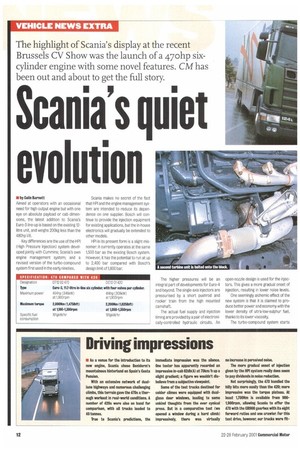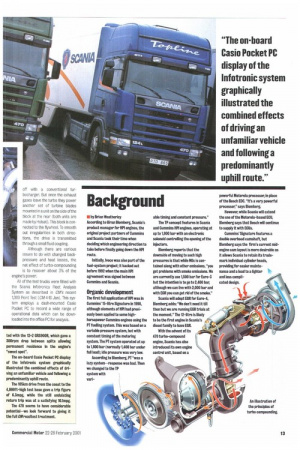Scania' s quiet
Page 14

Page 15

If you've noticed an error in this article please click here to report it so we can fix it.
evolution
The highlight of Scania's display at the recent Brussels CV Show was the launch of a 47ohp sixcylinder engine with some novel features. CM has been out and about to get the full story.
• by Colin Barnett
Aimed at operators with an occasional need for high output engine but with one eye on absolute payload or cab dimensions, the latest addition to Scania's Euro-3 line-up is based on the existing 12litre unit, and weighs 200kg less than the 480hp V8.
Key differences are the use of the HPI (High Pressure Injection) system developed jointly with Cummins; Scania's own engine management system; and a revised version of the turbo-compound system first used in the early nineties. Scania makes no secret of the fact that HPI and the engine management system are intended to reduce its dependence on one supplier. Bosch will continue to provide the injection equipment for existing applications, but the in-house electronics will gradually be extended to other models.
HPI in As present form is a slight misnomer: it currently operates at the same 1,500 bar as the existing Bosch system. However, it has the potential to run at up to 2,400 bar compared with Bosch's design limit of 1,800 bar.
The higher pressures will be an integral part of developments for Euro-4 and beyond. The single-axis injectors are pressurised by a short pushrod and rocker train from the high mounted camshaft.
The actual fuel supply and injection timing are provided by a pair of electronically-controlled hydraulic circuits. An open-nozzle design is used for the iliactors. This gives a more gradual onset of injection, resulting in lower noise levels.
One seemingly alchemic effect Of the new system is that it is claimed to produce better power and economy with the lower density of ultra-low-sulphur fuel, thanks to its lower viscosity.
The turbo-compound system starts off with a conventional turbocharger. But once the exhaust gases leave the turbo they power another set of turbine blades mounted in a unit on the side of the block at the rear (both units are made by Holset). This block is connected to the flywheel. To smooth out irregularities in both directions, the drive is transmitted through a small fluid coupling.
Although there are various issues to do with changed backpressure and heat losses, the net effect of turbo-compounding is to recover about 3% of the engine's power.
All of the test trucks were fitted with the Scania Infotronics Fleet Analysis System as described in CM'S recent 1,000 Point Test (CM 4-10 Jan). This system employs a dash-mounted Casio Pocket PC to record a wide range of operational data which can be downloaded into the office PC for analysis.




































































































